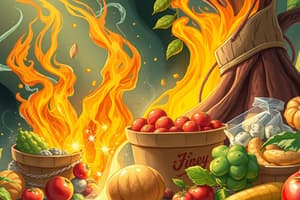Podcast
Questions and Answers
What type of hazard can cause illness or injury through contaminants?
What type of hazard can cause illness or injury through contaminants?
- Biological Hazards
- Physical Hazards
- Chemical Hazards (correct)
- Food Safety Risks
What is the transfer of harmful substances from one food or surface to another?
What is the transfer of harmful substances from one food or surface to another?
- Personal Hygiene
- Temperature Control
- Allergens and Intolerances
- Cross-Contamination (correct)
What is the process of identifying and controlling hazards in food production?
What is the process of identifying and controlling hazards in food production?
- Food Safety Regulations
- GMPs (Good Manufacturing Practices)
- HACCP (Hazard Analysis and Critical Control Points) (correct)
- Food Safety Standards and Codes
What should consumers do to ensure the safety of their food?
What should consumers do to ensure the safety of their food?
What should food handlers do to prevent the spread of illness?
What should food handlers do to prevent the spread of illness?
What are examples of physical hazards in food?
What are examples of physical hazards in food?
What is important to check when purchasing food?
What is important to check when purchasing food?
What should consumers do when there is a food recall?
What should consumers do when there is a food recall?
Which of the following is an example of indirect cross contamination?
Which of the following is an example of indirect cross contamination?
What is the primary source of cross contamination in a food establishment?
What is the primary source of cross contamination in a food establishment?
Which of the following is a risk factor for cross contamination?
Which of the following is a risk factor for cross contamination?
What is the recommended way to prevent cross contamination between raw and cooked foods?
What is the recommended way to prevent cross contamination between raw and cooked foods?
Which of the following foods is most likely to be a source of cross contamination?
Which of the following foods is most likely to be a source of cross contamination?
What is the purpose of separating raw and cooked foods in a food establishment?
What is the purpose of separating raw and cooked foods in a food establishment?
Flashcards are hidden until you start studying
Study Notes
Hazards in Food
- Biological Hazards: Bacteria, viruses, parasites, and fungi that can cause illness
- Examples: Salmonella, E. coli, Listeria, Norovirus
- Chemical Hazards: Contaminants that can cause illness or injury
- Examples: Pesticides, heavy metals, food additives
- Physical Hazards: Objects that can cause injury or choking
- Examples: Glass, metal, plastic, bone
Food Safety Risks
- Cross-Contamination: Transfer of harmful substances from one food or surface to another
- Temperature Control: Foods not stored or cooked at safe temperatures
- Personal Hygiene: Poor hand washing and hygiene practices by food handlers
- Allergens and Intolerances: Foods that can cause severe reactions or illness in some individuals
Safe Food Handling Practices
- Cleanliness: Wash hands, utensils, and surfaces frequently
- Separation: Separate raw, cooked, and ready-to-eat foods
- Cooking: Cook foods to recommended internal temperatures
- Chilling: Refrigerate or freeze foods promptly and at safe temperatures
- Labeling and Storage: Label and store foods properly to prevent spoilage and contamination
Food Safety Regulations and Guidelines
- HACCP (Hazard Analysis and Critical Control Points): A systematic approach to identifying and controlling hazards
- Good Manufacturing Practices (GMPs): Guidelines for food manufacturers to ensure safe and sanitary operations
- Food Safety Standards and Codes: Regulations and guidelines for food safety, such as the Food Safety Modernization Act (FSMA)
Consumer Food Safety Tips
- Buy from Safe Sources: Purchase foods from reputable sources and check expiration dates
- Handle and Store Safely: Handle and store foods safely to prevent contamination and spoilage
- Cook and Reheat Safely: Cook and reheat foods to recommended internal temperatures
- Be Aware of Recalls: Check for food recalls and follow recall instructions
Hazards in Food
- Biological hazards include bacteria, viruses, parasites, and fungi that can cause illness, such as Salmonella, E.coli, Listeria, and Norovirus.
- Chemical hazards involve contaminants that can cause illness or injury, including pesticides, heavy metals, and food additives.
- Physical hazards are objects that can cause injury or choking, such as glass, metal, plastic, and bone.
Food Safety Risks
- Cross-contamination occurs when harmful substances are transferred from one food or surface to another.
- Temperature control is crucial, as foods not stored or cooked at safe temperatures can cause illness.
- Poor personal hygiene practices by food handlers, such as inadequate hand washing, can lead to foodborne illness.
- Allergens and intolerances, such as peanuts or lactose, can cause severe reactions or illness in some individuals.
Safe Food Handling Practices
- Cleanliness is essential, with frequent washing of hands, utensils, and surfaces to prevent contamination.
- Separation of raw, cooked, and ready-to-eat foods is necessary to prevent cross-contamination.
- Cooking foods to recommended internal temperatures is crucial to kill harmful bacteria and viruses.
- Chilling foods promptly and at safe temperatures is necessary to prevent bacterial growth.
- Labeling and storing foods properly helps prevent spoilage and contamination.
Food Safety Regulations and Guidelines
- HACCP (Hazard Analysis and Critical Control Points) is a systematic approach to identifying and controlling hazards in food production.
- Good Manufacturing Practices (GMPs) provide guidelines for food manufacturers to ensure safe and sanitary operations.
- Food Safety Standards and Codes, such as the Food Safety Modernization Act (FSMA), regulate food safety practices.
Consumer Food Safety Tips
- Buying from safe sources, such as reputable stores and checking expiration dates, is essential.
- Handling and storing foods safely, such as keeping raw meat separate from ready-to-eat foods, prevents contamination and spoilage.
- Cooking and reheating foods to recommended internal temperatures prevents foodborne illness.
- Being aware of food recalls and following recall instructions helps prevent foodborne illness.
Cross Contamination
Definition
- Cross contamination occurs when harmful bacteria or contaminants are transferred from one food, surface, or person to another.
Types of Cross Contamination
- Direct cross contamination happens when contaminated food/surface comes into direct contact with ready-to-eat food.
- Indirect cross contamination occurs when contaminated food/surface comes into contact with an intermediate object (e.g., utensil, cloth) that then touches ready-to-eat food.
Common Sources of Cross Contamination
- Raw meat, poultry, and seafood can be contaminated with harmful bacteria.
- Unwashed fruits and vegetables can carry bacteria, viruses, and parasites.
- Uncooked eggs can contain Salmonella bacteria.
- Infected food handlers can spread illness through contaminated food and surfaces.
- Contaminated utensils, equipment, and surfaces can transfer bacteria to food.
Risk Factors
- Poor hand hygiene allows bacteria to spread from hands to food and surfaces.
- Inadequate cleaning and sanitizing of surfaces and equipment leaves bacteria behind.
- Insufficient cooking or refrigeration of food allows bacteria to multiply.
- Cross-contamination of ready-to-eat foods with raw or uncooked ingredients increases the risk of illness.
- Inadequate separation of raw and cooked foods can lead to cross-contamination.
Prevention Strategies
- Washing hands frequently with soap and warm water prevents the spread of bacteria.
- Regular cleaning and sanitizing of surfaces, utensils, and equipment reduces the risk of cross-contamination.
- Separating raw and cooked foods, and storing them in separate containers, prevents cross-contamination.
- Using separate utensils and cutting boards for raw and cooked foods prevents cross-contamination.
- Cooking food to recommended internal temperatures kills bacteria and other pathogens.
- Refrigerating perishable foods promptly and at a safe temperature (below 40°F or 4°C) slows bacterial growth.
Studying That Suits You
Use AI to generate personalized quizzes and flashcards to suit your learning preferences.




